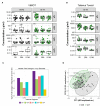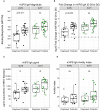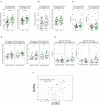IgA and IgG1 Specific to Vi Polysaccharide of Salmonella Typhi Correlate With Protection Status in a Typhoid Fever Controlled Human Infection Model
- PMID: 31781100
- PMCID: PMC6852708
- DOI: 10.3389/fimmu.2019.02582
IgA and IgG1 Specific to Vi Polysaccharide of Salmonella Typhi Correlate With Protection Status in a Typhoid Fever Controlled Human Infection Model
Abstract
Vaccination against Salmonella Typhi using the Vi capsular polysaccharide, a T-cell independent antigen, can protect from the development of typhoid fever. This implies that antibodies to Vi alone can protect in the absence of a T cell-mediated immune response; however, protective Vi antibodies have not been well-characterized. We hypothesized that variability in the biophysical properties of vaccine-elicited antibodies, including subclass distribution and avidity, may impact protective outcomes. To interrogate the relationship between antibody properties and protection against typhoid fever, we analyzed humoral responses from participants in a vaccine efficacy (VE) trial using a controlled human infection model (CHIM) who received either a purified Vi polysaccharide (Vi-PS) or Vi tetanus toxoid conjugate (Vi-TT) vaccine followed by oral challenge with live S. Typhi. We determined the avidity, overall magnitude, and vaccine-induced fold-change in magnitude from before immunization to day of challenge of Vi IgA and IgG subclass antibodies. Amongst those who received the Vi-PS vaccine, Vi IgA magnitude (FDR p = 0.01) and fold-change (FDR p = 0.02) were significantly higher in protected individuals compared with those individuals who developed disease ("diagnosed"). In the Vi-TT vaccine group, the responses of protected individuals had higher fold-change in Vi IgA (FDR p = 0.06) and higher Vi IgG1 avidity (FDR p = 0.058) than the diagnosed Vi-TT vaccinees, though these findings were not significant at p < 0.05. Overall, protective antibody signatures differed between the Vi-PS and Vi-TT vaccines, thus, we conclude that although the Vi-PS and Vi-TT vaccines were observed to have similar efficacies, these vaccines may protect through different mechanisms. These data will inform studies on mechanisms of protection against typhoid fever, including identification of antibody effector functions, as well as informing future vaccination strategies.
Keywords: Salmonella Typhi (S. Typhi); Vi polysaccharide; antibody; avidity; correlates of protection (CoP); humoral immunity; typhoid fever; vaccination.
Copyright © 2019 Dahora, Jin, Spreng, Feely, Mathura, Seaton, Zhang, Hill, Jones, Alam, Dennison, Pollard and Tomaras.
Figures






Similar articles
-
Vi-Vaccinations Induce Heterogeneous Plasma Cell Responses That Associate With Protection From Typhoid Fever.Front Immunol. 2020 Dec 3;11:574057. doi: 10.3389/fimmu.2020.574057. eCollection 2020. Front Immunol. 2020. PMID: 33424833 Free PMC article.
-
Specific and cross-reactive immune response to oral Salmonella Typhi Ty21a and parenteral Vi capsular polysaccharide typhoid vaccines administered concomitantly.Vaccine. 2015 Jan 9;33(3):451-8. doi: 10.1016/j.vaccine.2014.11.030. Epub 2014 Nov 26. Vaccine. 2015. PMID: 25433216
-
Efficacy and immunogenicity of a Vi-tetanus toxoid conjugate vaccine in the prevention of typhoid fever using a controlled human infection model of Salmonella Typhi: a randomised controlled, phase 2b trial.Lancet. 2017 Dec 2;390(10111):2472-2480. doi: 10.1016/S0140-6736(17)32149-9. Epub 2017 Sep 28. Lancet. 2017. PMID: 28965718 Free PMC article. Clinical Trial.
-
Typhoid conjugate vaccines: is a single dose enough for durable protection?Expert Rev Vaccines. 2025 Dec;24(1):194-205. doi: 10.1080/14760584.2025.2476525. Epub 2025 Mar 11. Expert Rev Vaccines. 2025. PMID: 40047496 Review.
-
Reexamination of the protective role of the capsular polysaccharide (Vi antigen) of Salmonella typhi.J Infect Dis. 1984 Sep;150(3):436-49. doi: 10.1093/infdis/150.3.436. J Infect Dis. 1984. PMID: 6207249 Review.
Cited by
-
Controlled human infectious models, a path forward in uncovering immunological correlates of protection: Lessons from enteric fevers studies.Front Microbiol. 2022 Sep 20;13:983403. doi: 10.3389/fmicb.2022.983403. eCollection 2022. Front Microbiol. 2022. PMID: 36204615 Free PMC article. Review.
-
A Salmonella Typhi Controlled Human Infection Study for Assessing Correlation between Bactericidal Antibodies and Protection against Infection Induced by Typhoid Vaccination.Microorganisms. 2021 Jun 28;9(7):1394. doi: 10.3390/microorganisms9071394. Microorganisms. 2021. PMID: 34203328 Free PMC article.
-
Typhoid fever.Nat Rev Dis Primers. 2023 Dec 14;9(1):71. doi: 10.1038/s41572-023-00480-z. Nat Rev Dis Primers. 2023. PMID: 38097589 Review.
-
Comparative immune response of Typbar TCV® (typhoid conjugate vaccine) in extremes of age: An Indian experience.Hum Vaccin Immunother. 2025 Dec;21(1):2507912. doi: 10.1080/21645515.2025.2507912. Epub 2025 May 30. Hum Vaccin Immunother. 2025. PMID: 40445123 Free PMC article. Clinical Trial.
-
Molecular correlates of vaccine-induced protection against typhoid fever.J Clin Invest. 2023 Aug 15;133(16):e169676. doi: 10.1172/JCI169676. J Clin Invest. 2023. PMID: 37402153 Free PMC article. Clinical Trial.
References
-
- Klemm EJ, Shakoor S, Page AJ, Qamar FN, Judge K, Saeed DK, et al. . Emergence of an extensively drug-resistant salmonella enterica serovar typhi clone harboring a promiscuous plasmid encoding resistance to fluoroquinolones and third-generation cephalosporins. MBio. (2018) 9:e00105–18. 10.1128/mBio.00105-18 - DOI - PMC - PubMed
Publication types
MeSH terms
Substances
Grants and funding
LinkOut - more resources
Full Text Sources
Other Literature Sources
Miscellaneous

